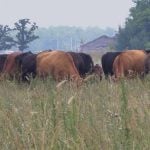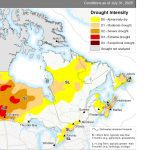Rene Lafond sees soil patches in his Manitoba fields but, remembering flooding two years ago, says the situation is fine.
“We’re happy to see this. Only the snowmobilers are hoping for snow,” said Lafond, adding there is only about a metre of snow in his shelterbelt compared to the typical two metres.
He has only used his snowblower once this year on his St. Jean Baptiste-area farm compared to several times a month most winters.
However, he’s not worried about spring seeding or his winter wheat. The latter still has some snow cover and mild temperatures prevented winterkill. He wants good moisture for spring seeding but thinks timely spring rain could do the job as well as snow.
Read Also

Alberta eases water access for riparian restoration
Alberta government removes requirement for temporary diversion licence to water plants up to 100 cubic metres per day for smaller riparian restoration projects
That’s a view most soil analysts across the Prairies share.
“Overall, winter snowpack doesn’t contribute a lot to spring moisture,” said Guy Ash, meteorologist with Manitoba Agriculture.
Often the snow melts too quickly to absorb well into the soil and much of the moisture evaporates into the air by spring seeding, said Ash while acknowledging the snow cover is good for winter wheat. Often, the key is good fall moisture and timely rain, he added.
That’s good news for farmers in Manitoba where there is generally little snow cover.
“Certainly Manitoba is known for its snowfall and this year we just don’t have it,” said Daryl Domitruk, of Manitoba Agriculture. “In some cases there’s bare field,” he said, noting there is minimal soil erosion in parts of southern Manitoba.
However, last fall provided good moisture and most of the province’s soil is at 60 to 90 percent moisture capacity, he said.
Most of his concern rests with potato and bean land, which is more prone to erosion because of less crop residue.
According to Environment Canada’s forecast for May 15, which considers fall moisture, snowfall and normal spring rainfall, Manitoba’s soil conditions should be fine.
In Alberta, the southern portion is the biggest concern, said Allan Howard, soil moisture specialist with Alberta Agriculture, adding parts of the Peace region also lack snow cover. Ideally, he’d like to see snow come in late March when the frost is coming out of the ground so the moisture will be conserved.
With normal rainfall, most parts of Alberta should have adequate soil conditions by spring speeding, according to Environment Canada information. However outlooks for areas around Calgary, Lethbridge and northern Alberta aren’t as good.
In Saskatchewan the west side of the province lacks moisture, said Ken Panchuk, soil specialist with Saskatchewan Agriculture. Environment Canada information shows areas around North Battleford could remain dry.
Producers concerned about soil moisture should take samples before seeding, said Howard. Less soil cultivation followed soon by seeding should conserve moisture, he said, adding direct seeding is probably the best way to go.
At any rate, producers shouldn’t worry yet, said Ash, emphasizing the unpredictability of weather.
“Don’t kid yourself. We could still have huge storms. March could be hell.”
















